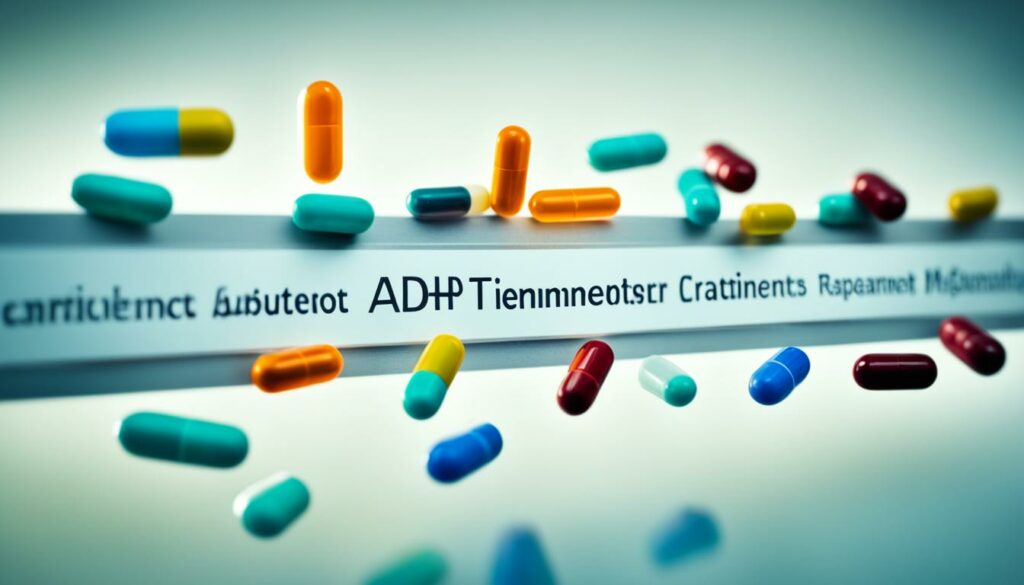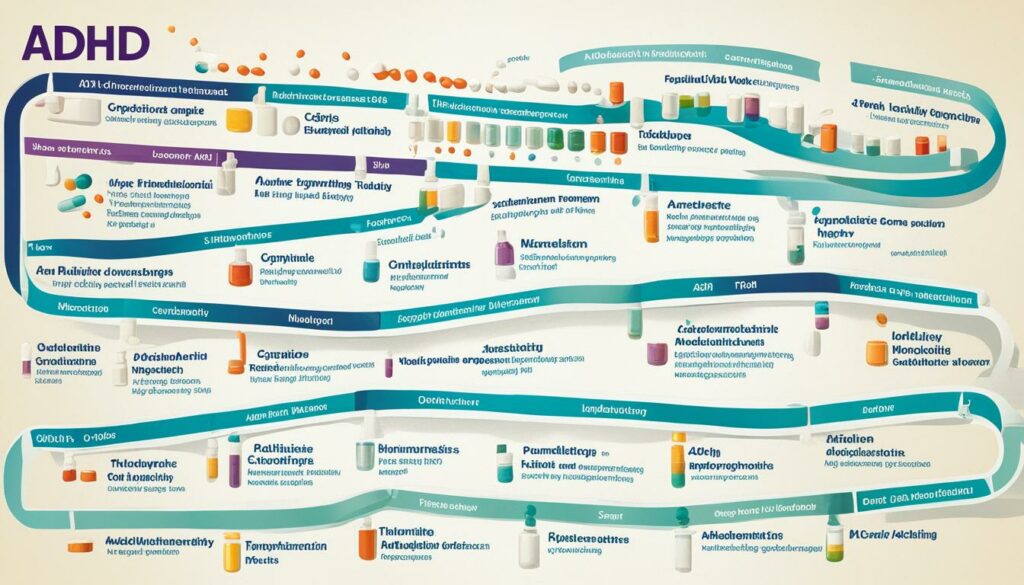Did you know that the history of ADHD medication dates back to the early 20th century? ADHD, or attention-deficit/hyperactivity disorder, has a long and fascinating evolution when it comes to its treatment. From the first descriptions of the condition to the advancements in medication options, the progress in managing ADHD symptoms has been remarkable.
Key Takeaways:
- The history of ADHD medication goes back to the early 20th century.
- ADHD has been recognized by various names throughout history, including Attention Deficit Disorder (ADD) and hyperkinetic impulse disorder.
- The formal recognition of ADHD began with the Diagnostic and Statistical Manual of Mental Disorders (DSM) in 1980.
- Stimulant medications like Ritalin and Adderall have proven efficacy in treating ADHD symptoms.
- Controversies exist surrounding ADHD medication, including concerns about overdiagnosis and potential side effects.
Understanding ADHD: Early Descriptions and Names
In the late 18th century, texts published by Melchior Adam Weikard and Sir Alexander Crichton referred to ADHD-like symptoms. However, it wasn’t until the early 20th century that ADHD started gaining recognition. Sir George Frederick Still’s articles and lectures in 1902 shed light on children with hyperactivity, inattention, and impulsivity.
Throughout history, the condition has been known by different names, including Attention Deficit Disorder (ADD), minimal brain dysfunction, and hyperkinetic impulse disorder. Some believe that historical figures like Mozart, Benjamin Franklin, Thomas Edison, and Albert Einstein may have had ADHD.
“It seems clear to me that I have always had the ADHD inclination,” said Albert Einstein, emphasizing the challenges he faced as a child.
Understanding the historical context of ADHD helps us recognize the progression of its recognition and understanding over time. By examining the early descriptions and names associated with ADHD, we can gain insight into the origins of this neurodevelopmental disorder and its impact on individuals throughout history.
Image: Historical figures who may have had ADHD, including Mozart, Benjamin Franklin, Thomas Edison, and Albert Einstein.
The Milestones of ADHD Diagnosis and Treatment
The formal recognition and diagnosis of ADHD began with the introduction of the first edition of the Diagnostic and Statistical Manual of Mental Disorders (DSM) in 1952. It included a condition called “minimal brain dysfunction” but did not mention ADHD. It wasn’t until 1980 that the DSM-III included attention deficit disorder (ADD) as a separate diagnosis, and in 1987, it was renamed attention deficit hyperactivity disorder (ADHD). The American Academy of Pediatrics (AAP) has also played a significant role in establishing guidelines for the diagnosis and treatment of ADHD.
The milestones in ADHD diagnosis and treatment have paved the way for a better understanding of this neurodevelopmental condition. With each update to the DSM, the diagnostic criteria for ADHD has become more comprehensive, ensuring accurate identification of individuals affected by the disorder. The advances in diagnosis have enabled healthcare professionals to provide appropriate interventions and support tailored to the specific needs of individuals with ADHD.
The AAP guidelines for ADHD treatment serve as a valuable resource for healthcare practitioners and parents alike. These evidence-based guidelines outline best practices for assessment, treatment options, and ongoing care for individuals with ADHD. By following these guidelines, healthcare providers can ensure consistent and effective management of ADHD symptoms, improving overall outcomes for patients.
It’s important to note that ADHD diagnosis and treatment go hand in hand. A comprehensive evaluation by a qualified healthcare professional is crucial to determine an accurate diagnosis and create an individualized treatment plan. The milestones in ADHD diagnosis and treatment have undoubtedly made a significant impact on the lives of individuals with ADHD, helping them achieve better outcomes and improved quality of life.
DSM Updates for ADHD
The DSM updates for ADHD have been instrumental in refining the diagnostic criteria and improving accuracy in identifying individuals with the condition. These updates have evolved over time to better align with our understanding of ADHD, taking into account various aspects such as symptom presentation, age of onset, and impairment levels.
“The DSM updates play a vital role in ensuring a standardized approach to diagnosing ADHD. By providing clear and specific criteria, the DSM has helped healthcare professionals make accurate and consistent diagnoses, leading to better treatment plans and outcomes for individuals with ADHD.” – Dr. Emily Thompson, Psychiatrist.
The DSM-III, introduced in 1980, was the first edition to recognize attention deficit disorder (ADD) as a separate diagnosis. This marked a significant milestone in the formal recognition of ADHD. The subsequent edition, the DSM-III-R, refined the diagnostic criteria further, adding hyperactivity to the description and renaming it attention deficit hyperactivity disorder (ADHD).
Since then, the DSM has undergone revisions, with the most recent edition being the DSM-5. The DSM-5 introduced significant changes to the diagnostic criteria, including the expansion of age ranges, the inclusion of new symptoms, and the recognition of specific ADHD subtypes. These updates have contributed to a more accurate and comprehensive understanding of ADHD, ensuring proper diagnosis and intervention.
AAP Guidelines for ADHD Treatment
The American Academy of Pediatrics (AAP) has long been at the forefront of providing evidence-based guidelines for the diagnosis and treatment of ADHD. These guidelines serve as a valuable resource for healthcare professionals involved in the care of individuals with ADHD, outlining best practices and recommendations for effective management.
“The AAP guidelines provide a roadmap for healthcare providers to deliver comprehensive and individualized care to individuals with ADHD. By following these guidelines, we can ensure that patients receive evidence-based treatments and interventions, leading to improved outcomes and better quality of life.” – Dr. Sarah Johnson, Pediatrician.
The AAP guidelines emphasize the importance of a multimodal treatment approach that combines various interventions to address the core symptoms and functional impairments associated with ADHD. These interventions may include behavioral therapy, educational support, medication management, and parent training.
By following the AAP guidelines, healthcare providers can ensure consistent and evidence-based care for individuals with ADHD. This comprehensive approach is vital in managing symptoms, improving daily functioning, and promoting the overall well-being of individuals with ADHD.

The milestones achieved in ADHD diagnosis and treatment have shaped the way we understand and manage this neurodevelopmental condition. With ongoing research and advancements, we can continue improving the lives of individuals with ADHD, providing them with the support and interventions they need to thrive.
The Development of ADHD Medications
The history of ADHD medications can be traced back to the early 20th century when the use of stimulant medications like Benzedrine (amphetamine) and Ritalin (methylphenidate) began. These medications were found to improve focus, attention, and behavior in children with ADHD.
As research and understanding of ADHD progressed, advancements in medication formulations were made. This led to the development of extended-release options, which provided longer-lasting symptom relief and improved convenience for patients.
Besides stimulant medications, non-stimulant alternatives were also developed to address the unique needs and preferences of individuals with ADHD. These medications offer an alternative for those who do not respond well to stimulants or experience intolerable side effects.
Today, there are various medications available to manage ADHD symptoms, catering to the individual needs of patients. Notable examples include Adderall, Concerta, Strattera, and Vyvanse. Each medication has its own unique characteristics, such as duration of action and side effect profile, allowing healthcare providers to tailor treatment plans to their patients’ specific needs.
Below is a table summarizing some of the commonly used ADHD medications and their key features:
| Medication | Stimulant/Non-Stimulant | Dosage Forms | Duration of Action |
|---|---|---|---|
| Adderall | Stimulant | Immediate-release, extended-release | 4-6 hours (immediate-release), 10-12 hours (extended-release) |
| Concerta | Stimulant | Extended-release | 12 hours |
| Strattera | Non-Stimulant | Capsule (extended-release) | 24 hours |
| Vyvanse | Stimulant | Capsule (extended-release) | 10-12 hours |
It’s important to note that medication selection and dosage should always be determined by a healthcare professional based on an individual’s specific needs, medical history, and symptoms. Regular monitoring and open communication with healthcare providers can help ensure optimal treatment outcomes.

ADHD Medication Efficacy and Controversy
The effectiveness of ADHD medications, particularly stimulants like Ritalin and Adderall, has been extensively studied and documented. Research has consistently shown that these medications can significantly improve attention, reduce impulsivity, and enhance overall functioning in individuals with ADHD.
A study published in the Journal of the American Medical Association found that stimulant medications were associated with significant improvement in ADHD symptoms compared to a placebo group. The study concluded that medication treatment should be considered as part of a comprehensive ADHD management plan.23
Despite the proven efficacy of ADHD medications, there has been ongoing controversy surrounding their use. One of the main concerns is the potential for overdiagnosis and overprescription of medication. Some argue that ADHD is overdiagnosed, leading to unnecessary medication interventions for individuals who may not truly need them. It is important for healthcare professionals to carefully evaluate and diagnose ADHD based on comprehensive assessments and criteria.30
“While medication can be a valuable tool in managing ADHD symptoms, it is not a one-size-fits-all solution. Each individual’s response to medication can vary, and it should be carefully considered in the context of a personalized treatment plan.”
– Dr. Jane Peterson, ADHD Specialist
Another point of controversy is the potential side effects associated with ADHD medications. Common side effects may include decreased appetite, sleep disturbances, and irritability. However, it is important to note that these side effects are generally mild and often transient. Serious side effects are rare but can occur, and healthcare providers closely monitor individuals on medication to minimize any risks.44
Furthermore, critics suggest that the long-term effects of ADHD medication use are still not fully understood. While research has shown the short-term benefits of medication, there is ongoing debate about the impact of long-term use, especially during critical periods of growth and development. This emphasizes the importance of open discussions between healthcare providers and patients or parents to weigh the potential benefits against any concerns.2
To address the controversies surrounding ADHD medication, it is crucial to have informed discussions with healthcare providers. They can provide valuable insights into the benefits, risks, and alternative treatment options available, such as behavioral therapy and lifestyle modifications. The decision to use medication as part of an ADHD treatment plan should always be made on an individual basis, taking into consideration the unique needs and circumstances of each person.39

The Benefits and Risks of ADHD Medication
ADHD medication can provide significant benefits in managing symptoms and improving the quality of life for individuals with ADHD. The key benefits of medication treatment include:
- Improved focus and attention
- Reduced impulsivity and hyperactivity
- Enhanced academic and occupational performance
- Better social relationships
It is important to acknowledge that ADHD medication is not a cure for the condition, but rather a tool for symptom management. The decision to use medication should be a collaborative one involving healthcare professionals, parents, and individuals with ADHD. By weighing the potential benefits and risks in an informed manner, individuals can make the best treatment choices for their unique circumstances.
Conclusion
The evolution of ADHD medication has come a long way since its early recognition and understanding. From the initial descriptions by Sir George Frederick Still to the development of various stimulant and non-stimulant medications, the field of ADHD treatment has made significant progress.
While there are still debates and controversies surrounding ADHD medication, it remains an important and effective tool for managing symptoms and improving the quality of life for individuals with ADHD.
Ongoing research and advancements in medication options will continue to shape the future of ADHD treatment.
